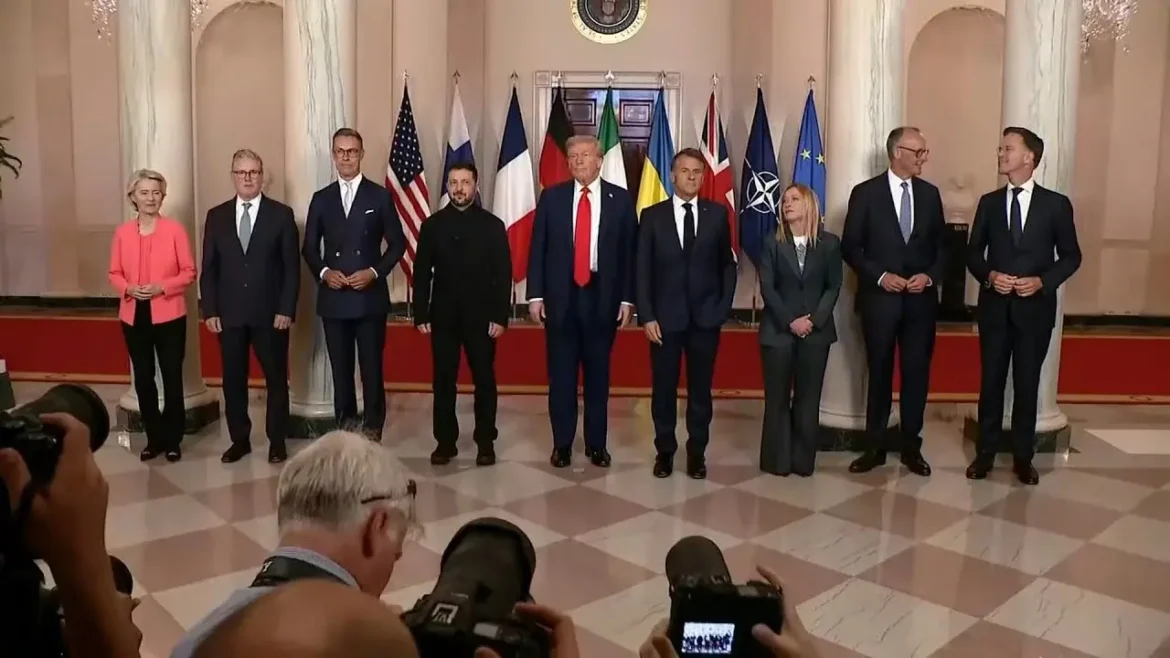By Desmond Nleya
Zelenskyy met Trump one-on-one in the Oval Office, followed by an expanded session in the East Room with a heavyweight European contingent (von der Leyen, Rutte, Macron, Starmer, Merz, Meloni, Stubb, among others). The Europeans arrived as a united phalanx to both demonstrate resolve and ensure Kyiv wasn’t cornered into a deal it cannot live with. The East Room meeting ran over two hours; talks then resumed in a smaller “leaders-only” format.
Key takeaways
A push for “peace—fast,” but few hard details. Trump framed the objective as an immediate ceasefire and a rapid end to the war, while floating that any settlement could involve “territorial” questions left to consent between Zelenskyy and Putin. That signals openness to land-for-peace tradeoffs—even as Ukrainians and most Europeans reject border changes by force.
Europe arrived as Zelenskyy’s political armor. Multiple leaders joined to reinforce Kyiv’s red lines and avoid a repeat of February’s fraught Oval Office encounter. Their presence raised the political cost of any quick fix that undercuts Ukrainian sovereignty.
Security guarantees are the bridge concept. Discussion centered on “Article 5-like” guarantees and a division of labor in implementation—Europe footing much of the long-term bill and logistics, the U.S. shaping architecture and deterrence. Details remain undefined.
Strategic implications
Deal geometry is shifting from ‘aid’ to ‘architecture’. Washington is testing whether security guarantees (training, air defense, long-range strike constraints, ISR sharing) can substitute for formal NATO membership to unlock a ceasefire. The more concrete and enforceable these guarantees, the more leverage Kyiv retains at the table; the vaguer they are, the more they risk freezing a bad status quo.
Territorial ambiguity is now explicit. Acknowledging that “territorial exchanges” are on the table normalizes Russia’s objective—at least rhetorically—even if final decisions are said to rest with Kyiv. That can pressure Ukraine to accept losses under fire, which many Europeans sought to counter by showing up in person.
The Wall Street Journal
The Guardian
Alliance management is the hidden variable. The EU and UK swallowed recent U.S. tariff hikes partly to keep Trump aligned on Ukraine. If the White House leans harder on a rapid settlement, expect Europeans to trade economic concessions for tougher security terms for Kyiv.
PBS
Does Europe “control” Ukraine?
It’s true that Europe’s leverage is enormous—financial lifelines, ammunition pipelines, energy support, refugee policy, and now the design of any guarantees. That can look like over-control, especially when Kyiv is absorbing daily strikes. But agency still rests with Ukraine: European leaders emphasized publicly that only Ukraine decides on its territory and that borders can’t be altered by force. The Europeans’ Washington presence was less about puppeteering and more about raising the floor under any prospective deal.
Why the U.S. is indispensable as broker
Deterrent credibility. No actor besides the U.S. can credibly underwrite air and missile defense integration, long-range strike de-confliction, and real-time ISR that would make a ceasefire hold rather than collapse.
Leverage over Moscow. Whether via sanctions design, oil price-cap enforcement, or military aid pacing, Washington’s dials shape the costs to Russia of non-compliance. A broker needs sticks as well as carrots; the U.S. has both.
Council on Foreign Relations
Alliance orchestration. Europe can fund and sustain, but someone must harmonize the patchwork of guarantees, timelines, and triggers. That’s a U.S. role by default—and design.
What this meeting did not do
It did not lock in a ceasefire or a territorial map. There’s no agreed text, no monitoring regime, no sequence for withdrawals or inspections. Think “framing session,” not Dayton-style clincher.
Council on Foreign Relations
It did not resolve the ammunition and air defense shortfall shaping realities at the front this month. Guarantees without immediate kit are promises on paper.
What’s next (watch these markers)
A written “security guarantees” draft. Look for concrete clauses: air defense coverage, response timelines to violations, sanctions snap-backs, and who pays for what. If those terms are fuzzy, risks of a frozen conflict skyrocket.
The Washington Post
Putin–Zelenskyy channel. Reports indicate momentum toward direct talks. Whether that’s substantive or stagecraft will show in whether battlefield strikes are dialed down in parallel.
The Guardian
European burden-sharing pledges. Expect an EU-UK package that pairs industry ramp-ups with long-term financing—proof that “Europe implements” isn’t just a slogan.
The Wall Street Journal
U.S. domestic signaling. Watch if the White House pairs any deal talk with a replenishment ask to Congress; if not, Kyiv’s near-term capacity remains constrained.
ABC News
Bottom line
The White House huddle signaled urgency and opened a path, but also surfaced tensions between speed and sovereignty. Europe’s show of force aimed to keep Kyiv’s agency intact. If Washington now converts rhetoric into a real, enforceable guarantee regime, it can credibly broker peace. If the deal leans on ambiguous “land for peace” formulas without teeth, it risks baking in instability—with Ukraine still carrying the heaviest cost.


